|
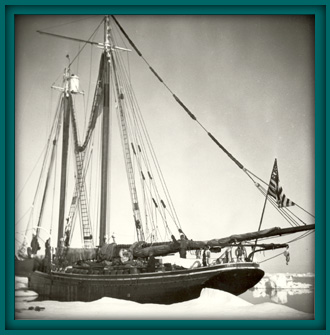
The Schooner Effie M.
Morrissey at furthest north at 80 degrees 22 minutes 3o
seconds North Latitude
|
|
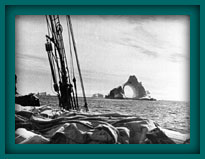


Charmichael (she) was taken to the Philadelphia Zoo
|
Hundreds
of experiments and studies were carried out from
the Morrissey's decks over the years including
charting Greenland and Alaskan waters,
oceanographic sampling, Arctic plant and animal
collections and anthropological studies of Innuit
life.
In 1940 the Morrissey set a record for furthest north at 80
degrees 22 minutes North Latitude. That's only 578 nautical
miles from the North Pole!
As a result of the Pathe Newsreels that were produced and
the incredible effort by the Bartlet's Boys of the 1940
expedition especially, notably Fred Littleton, Austen Colgate,
John Pitcairn, Jim Pond, David Nutt, Reggie Wilcox, George
Hodge and others,
there is a great record we will be adding on this page as we
get to it from time to time.
If you would like to read a logbook from this trip click
here to go to John
Pitcairn's log....
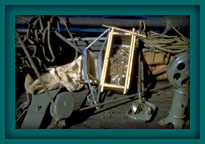
|
|
Captain Robert A. Bartlett
The Mates Watch
William Bartlett, Mate
Austin Colgate
George Hodge
Arthur Manice
Albert Barnes
Rupert Bartlett
The Boatswain’s Watch
George Richards, Boatswain
Albert Hoffman, Jr.
Warren Ripley
Edward A. Darr, Jr.
Samuel Bartlett
John P. Pitcairn
|
George Bartlett’s Watch
George
Bartlett
Charlie Batten
Fred Littleton
Albert
Park
James Pond
Reginald Wilcox, Cameraman
Extra Hands
William Pritchard---Cook
Thomas Pritchard--- Asst. Cook
Leonard Gushue--- Chief Engineer
Bart
Gushue--- Asst. Engineer
James Dooley---A. B.
David Nutt ---Curator
Alan Eurich—Radioman
Dr. Mantor---Ship’s Doctor
|
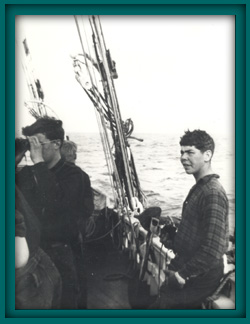
Frederick C.
Littleton taking photos (right), Fred often gave Reggi Wilcox
a hand when the film footage was needed from aloft
|
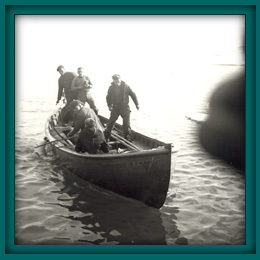
Bringing in
a polar bear cub to be taken to a zoo. This may be Charmichael
who ended up at the Philadelphia Zoo. Aboard the boat are Art
Manice, Reggi Wilcox (photographer), David Nutt, Rupert
Bartlett, and George Hodge. |
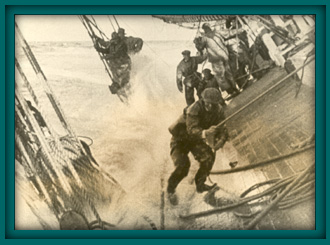
The ship sails along with a
good wind up |
|
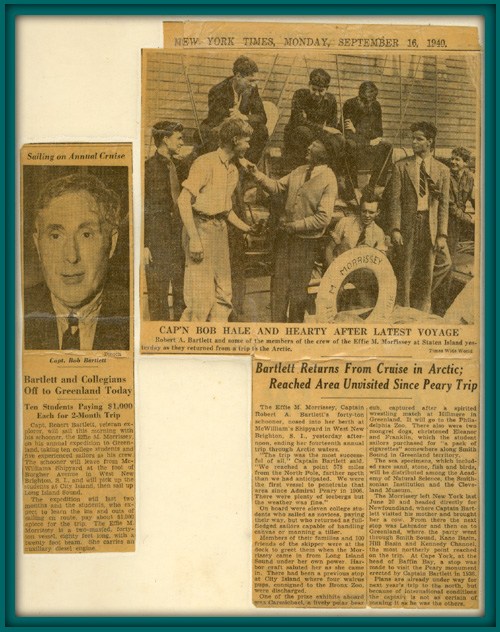
Here is an
article that appeared after the ship returned.
Bartlett often made papers like the New York Times.
In the photo
from the NYTimes the identity of each is (left to right)
Sitting on the main gaff beginning aft and working forward:
Warren Ripley (who was shot down and killed while flying
during the war), Fred Littleton, and George Hodge
Standing: Jim Pond, Albert Barnes (we called him
shellback because he "always knew everything"), the
captain, John Pitcairn (sitting and holding the life ring), Ed
Darr, Austen Colgate
|
|
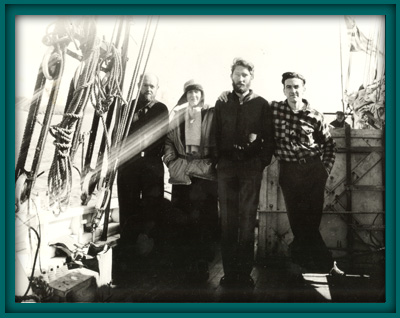
Shown on the
deck of the Effie M. Morrissey on October 29, 1941 is
Frederick R. Gracely, National Bureau of Standards (NBS); Louise
Arner Boyd; Archer S. Taylor,
NBS; and T. A. Carrol, US Coast Guard radio operator.
This
five-month Greenland Expedition was the 7th into the Arctic
regions sponsored by Louise A. Boyd of San Francisco, CA,
during the period of 1926 to 1941. At the request of Lyman A.
Briggs, Director of the Department of Commerce National Bureau of
Standards, Miss
Boyd, for the first time, set a course along the west coast of
Greenland into the Baffin Bay region. It was the first
opportunity by NBS for an extensive study of the ionosphere at
Arctic latitudes. Photo from Archer S. Taylor.
An Excerpt from the U.S. Department of
Commerce Technical News Bulletin of the National Bureau of
Standards, Washington, December 1941, Number 296:
Return of Louise A. Boyd Arctic Expedition It
was announced in Technical News Bulletin 291 (July 1941) that the
Louise A. Boyd Arctic Expedition, carrying on scientific work for
the Bureau sailed from Washington on June 11. It returned to
Washington November 3 after a successful voyage up the west coast
of Greenland and down the coast of Baffin Land and Labrador. The
personnel of the expedition included Miss Louise A. Boyd, leader;
A. S. Taylor and F. R. Gracely, of the Bureau's Radio Section; a
radio operator detailed by the Coast Guard; a physician; Capt.
Robert A. Bartlett, master of the ship,. the Effie M. Morrissey;
and a crew of eleven. Miss Boyd contributed her
long experience as an arctic explorer and the services of this
expedition, to aid in the Bureau's radio work, having been
appointed a consulting expert of the Bureau on a dollar a year
basis. The principle purpose of the expedition was
to secure data on radio-wave propagation in the regions traversed.
Special radio recording equipment and apparatus for determining
characteristics of the ionosphere were taken and were operated
continuously throughout the voyage. The ionosphere is the
electrically conducting region high in the earth's atmosphere
which makes long-distance radio transmission possible. Indirect
evidence had indicated that radio transmission conditions in the
arctic regions differ considerably from those elsewhere. As the
paths traversed by radio waves from the United States to many
parts of the world include arctic regions, it was important to
secure data on the radio conditions there. This objective was very
satisfactorily achieved by the expedition. The same
conditions in the ionosphere which affect radio transmissions
affect other physical happenings also, especially terrestrial
magnetism. For this reason magnetic data are also of interest in
the scientific study of radio transmission, and the expedition
carried magnetic measurement equipment, loaned for the purpose by
the Carnegie Institution of Washington, Department of Terrestrial
Magnetism. Valuable data were secured on magnetism and also on the
aurora, the effects of which are closely related to magnetism and
to radio transmission. Continuous measurements were also made on
ultraviolet light intensity. The Government is
indebted to Miss Boyd for her effective leadership of the
expedition and is gratified with the results achieved. z
The following information came from Microsoft
Encarta:
Louise Arner Boyd
Boyd, Louise Arner (1887-1972), American
explorer of the Arctic Ocean and the first woman to fly over
the North Pole. Boyd was born to a wealthy family in San
Rafael, California, a suburb of San Francisco. Boyd inherited
her family's fortune in 1920 and spent the next few years
traveling in Europe. Her interest in polar exploration began
in 1924 when she first visited Arctic regions aboard a
Norwegian cruise ship. Two years later Boyd chartered a
Norwegian ship and took a group of friends on a trip from
Norway into the Arctic Ocean. They visited Franz Josef Land,
the island chain north of European Russia, where they hunted
polar bears and seals. In 1928 Boyd led an expedition to find
Norwegian Arctic explorer Roald Amundsen, who had disappeared
while flying a rescue mission in search of Italian explorer
and engineer Umberto Nobile. Financing the venture herself,
Boyd set out on behalf of the Norwegian government on a voyage
across about 16,100 km (about 10,000 mi) of the Arctic Ocean,
exploring from Franz Josef Land in the east to the Greenland
Sea in the west. She was unable to find any trace of Amundsen,
but for her efforts the Norwegian government awarded Boyd the
Chevalier Cross of the Order of Saint Olav.
Beginning in 1931, Boyd undertook a series
of nearly annual expeditions to the Arctic. That year she and
an exploring party sailed to Greenland's northeastern coast,
where they examined glacial formations and photographed Arctic
plant and animal life. She earned recognition for her
explorations of the little-known De Geer Glacier when an
adjoining region was later named Louise Boyd Land. In 1933
Boyd led an expedition sponsored by the American Geographical
Society. Her scientific team again studied the fjords and
glaciers on Greenland's northeastern coast and, using a sonic
device, measured the offshore ocean depths. In 1937, and again
in 1938, Boyd continued her ocean-depth research in the Arctic
seas northeast of Norway. These two expeditions helped
determine that an undersea mountain ridge spans the ocean
floor between Bear Island and Jan Mayen Island.
The outbreak of World War II in 1939 halted
Boyd's explorations until 1941, when she undertook an Arctic
expedition sponsored by the United States government. She
studied the effects of polar magnetic phenomena on radio
communications and later served as an adviser on military
strategy in the Arctic. [This was the voyage on the
Morrissey.] In 1949 the U.S. Army awarded her a
Certificate of Appreciation in recognition for this work. Boyd
returned to the Arctic again in 1955 when, at the age of 68,
she hired an airplane and became the first woman to fly over
the North Pole. She spent her remaining years in San
Francisco. Boyd wrote about her explorations in newspaper
articles and in her books The Fjord Region of East Greenland
(1935) and The Coast of Northeast Greenland (1948).
Contributed by: Alan Wexler
"Boyd, Louise Arner" Microsoft(R)
Encarta.
Copyright(c) 1995 Microsoft Corporation. |
|